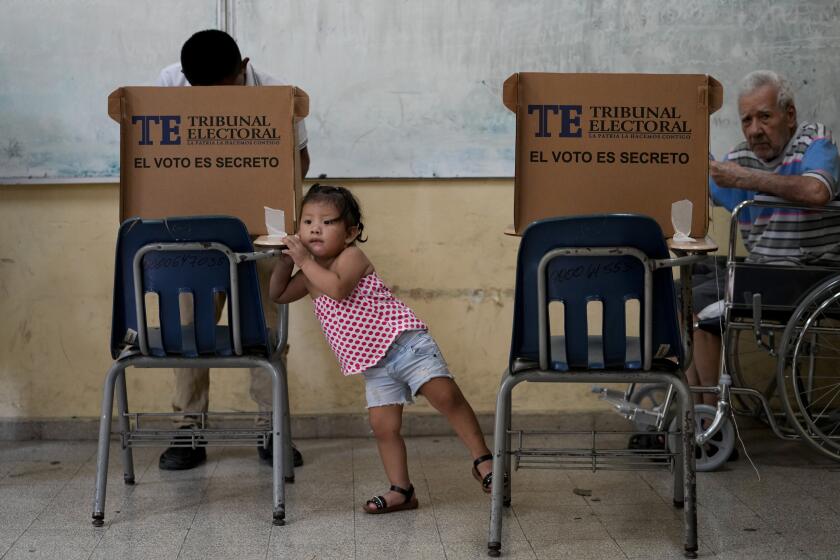COMPANY TOWN : Chinese Wiring the Countryside for Satellite TV : Television: Program is the first experimental step in building a nationwide direct-to-home system.
For centuries, the people of this outpost in the rugged mountains of southwest China were so isolated that many of them didn’t even know who their country’s leaders were. Now they see them every night on satellite TV.
The 1,400 villagers, members of the Kucong hill tribe, are the beneficiaries of a new program by China’s government to make sure that news of the world--or at least the version of it offered by the Communist Party’s propaganda organs--can penetrate even the most remote corners of this vast country. Industry analysts say the program is the first experimental stage in building a nationwide direct-to-home satellite TV system, and a step toward eventually reversing a ban on the private use of satellite dishes, which China has enforced sporadically since 1993.
The emerging satellite TV industry is a crucial front in a larger struggle for control of information technologies in China. Many Chinese officials are convinced that satellites are the technological wave of the future that will someday serve as a platform for profitable pay-per-view TV, Internet access and video-on-demand services.
But to the propaganda establishment, the concept of DTH connotes potentially subversive foreign programming and lack of government control. Therefore, proponents of DTH within the government have recast it as a nonprofit public service for economic development and propaganda. Their name for the project can be roughly translated as Every Village Wired.
“We’re doing direct broadcast satellite TV as an experiment,” said Liu Yiqin, vice president of China Central Television. “Ordinary citizens can directly receive it [satellite broadcasts]. But we’re only doing it . . . in the countryside. If it goes well and we decide to expand it, then that would be the next issue.”
The program’s stated goal is to achieve 100% television coverage, versus the current 86%. According to official statistics, China still has nearly 100,000 small villages that don’t receive any television signal. Of these, 30,000 villages are still without electricity. Most of them are in China’s poor inland provinces.
Two years ago, a dirt road winding through verdant peaks and gorges became Ma Deng Village’s first link with the outside world. It still takes residents a day’s journey to get to the nearest sizable town, some 180 miles away, to do business and buy supplies.
Last year, the village got electricity. Until the government began installing the first satellite dishes in February, there were no televisions and no television signals to receive. Since the dishes were installed, villagers have bought 86 televisions.
One of these belongs to Liu Yonglan, a middle-aged shopkeeper and one of the more prosperous villagers. Earlier this year, she rode her tractor into town and brought back a satellite dish and integrated receiver-decoder.
On a rainy afternoon on Ma Deng Village’s main street, half a dozen kids are watching a kung fu costume drama in Liu’s shop. “I try not to let them watch too much on weekdays, and I don’t like them watching a lot of violence,” Liu says.
Liu surfs between China Central Television, the Yunnan provincial channel and 10 other provincial satellite channels. They are beamed directly from the Apstar satellite, made by Hughes Electronics Corp. of El Segundo.
CCTV’S main function is to carry the voice of the party. Its most important program is the 7 p.m. news, watched by an estimated 800 million viewers. In recent years, CCTV has added channels for arts, science, movies and sports. Most of China’s provinces now have their own satellite TV channels, which punctuate their entertainment with local news and advertising.
Though these signals go directly from the satellite into Liu’s home, they are not part of a commercial DTH platform such as DirecTV in the U.S., which has a sophisticated billing system so that viewers can pay for encoded programming.
At present, experts estimate China has as many as 1 million satellite reception systems, legal and illegal, in individual households such as Liu’s, although official figures put the number of officially approved systems at just 350,000.
The government does not encourage peasants to follow Liu Yonglan’s example, and permits rural residents to install their own dishes only with special permission (although money and connections seem to help the approval process).
The government prefers rural residents to use communal satellite dishes attached to local cable networks or relay transmitters. These are installed through the Every Village Wired project, and can be monitored and controlled by officials. This keeps viewers from aiming their satellite dishes away from government broadcasts and toward banned foreign programming. China permits the reception of foreign broadcasts by only hotels and housing compounds catering to foreigners.
“We must not let them learn” how to aim their dishes at other satellites, said one propaganda official.
For those with the money or technical know-how to receive and unscramble the signals, the skies over China are alive with broadcasts from a dozen satellites, beaming down at China everything from HBO and MTV to the Disney and Golf channels.
Indeed, China’s cities are home to a thriving subculture of satellite TV aficionados who fiddle with electronic equipment for the high-tech rush of picking up satellite broadcast signals in a language they often don’t understand.
“Really, nobody bothers us,” said one such hobbyist, who now installs satellite dishes in Beijing for a living. He caters mostly to foreigners, Taiwanese and Hong Kong businessmen, and other urbanites who dare to defy the ban by planting dishes on unseen rooftops.
Many large compounds that house government employees ignore bans on receiving foreign satellite broadcasts, picking up whichever signals they please from their satellite master antennae and feeding them to their residents via cable networks.
As a result, many of China’s elite have watched banned satellite broadcasts for years. Their channel of choice is usually Phoenix, a joint venture between Rupert Murdoch’s Hong Kong-based Star TV and a consortium of Chinese companies. The station features Taiwanese soap operas, game shows and news coverage that sticks to the Communist Party line. Although officially illegal for Chinese to watch, Phoenix has gradually won a degree of tacit government approval.
While waiting for the day when DTH becomes available to paying urban customers--which analysts say could take several years--a host of domestic and foreign players are lobbying the government and jockeying for position to provide equipment and programming.
China’s electronics industry, for example, is eager to provide low-cost satellite-related equipment, the manufacture of which is currently restricted to several dozen officially approved firms.
The market for broadcast satellites in China is dominated by three U.S. firms: Loral, Hughes and Lockheed Martin. In a recent deal, Milpitas, Calif.-based Divicom has supplied encoding equipment for the nascent DTH program.
CCTV has also purchased a foreign-made subscriber management system and plans to launch more digital broadcast satellites, which will give viewers a choice of about 30 domestic channels by 2000.
Once the DTH platform is in place, the crucial missing ingredient will, of course, be foreign programming. Barring major liberalization of Chinese media, U.S. companies such as HBO and MTV will be shut out.
And foreign programmers are skeptical that DTH in China can be commercially viable without their content.
Consumers are unlikely to pay for DTH unless it can deliver programming that is not available from China’s 1,300 public cable networks, said Michelle Sie, president of Denver-based Encore International, which sells blocks of U.S. programming to CCTV.
“I don’t see that digital broadcast satellite TV is about to take off,” Sie said.
More to Read
Start your day right
Sign up for Essential California for news, features and recommendations from the L.A. Times and beyond in your inbox six days a week.
You may occasionally receive promotional content from the Los Angeles Times.






